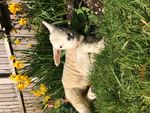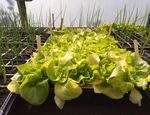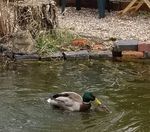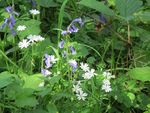TEAM UP! - WARWICKSHIRE WILDLIFE TRUST
←
→
Page content transcription
If your browser does not render page correctly, please read the page content below
TEaM Up!
Bringing people, wildlife and wellbeing together
This week, Anna shares with us the joy of spring lambing:
I haven’t had the easiest of 2021’s so far, and finding joy in things has been
a daily challenge. So I was delighted when lambing time came around this
year and the time for new life began. We have a small flock of sheep, some
Jacob sheep which are spotty and some Texel sheep which are plain white.
This year we had 4 who were due to lamb and we spent many days
keeping a watchful eye on them, waiting for the telltale signs of being ready
– a big udder, pawing the ground a lot, staying away from the flock. But no
matter how prepared you are, or how many times you have seen a lamb
being born before it’s still a wonder to behold. It’s amazing to see their
natural instincts kicking in – they immediately try to stand and look for their
mother’s milk.
We had 4 lambs born with no problems at all, but we had one ewe (female
sheep) who was new to lambing, being a first time mum, and she wasn’t
very keen! Shortly after her lamb was born she simply wandered off,
showing no maternal instincts at all, leaving her lamb all alone. This is always
heartbreaking, but also an opportunity to bottle feed! So we took the little
lamb, a girl, home with us and she was bottle fed by us in our kitchen for 4
weeks. Her name is Alpha, and spending so much time with people she is
very friendly and acts more like a dog than a lamb, following us around! She
even plays a bit of football with my son’s small inflatable ball – headbutting
the ball around the garden to join in the match! She gave me moments of joy,
and did for my family too.
When things seem so hard, and like they may never get better, life has a way
of giving you a little lift if you let it. For me the lamb was a little lift! But I also
get it from seeing birds in the garden, or watching the butterflies flit absent
mindedly from flower to flower, or seeing the new growth on my roses. Letting
nature lift you can be such a powerful way to help us all heal. I am looking
forward to watching Alpha grow and change and to lambing next year.
You can also follow TEaM on social media for a Daily Dose of Nature...
The Environment and Me theenvironmentandme @TheEnviroandMeBluebells and Brown Hares
With the easing of lockdown I have taken
advantage of being allowed to travel and
decided to visit some of my favourite
places such as Merrible Wood, an
ancient wood in Leicestershire to see the
display of bluebells.
To classify a wood as ancient it has to be over 400 years old, which
means they had been woodlands in the medieval times around
1600AD. Ancient wood has complex and rich ecosystems that are
irreplaceable. Some of these woods are filled with carpets of bluebells
and wood anemones at this time of the year. These spring flowers are
an indication that the site has been continuously wooded for hundreds
of years. There is only 2.5% of the UK land that is covered in ancient
woodland, approximately 610,000 hectares.
The best time of the year to see beautiful displays of bluebells is late
April to mid-May. You can see them in Ryton, Wappenbury,
Bubbenhall, Tocil woods just to name a few places. In these woods are
native bluebells.
Native bluebell (Hyacinthoides non-scripta) are different to the Spanish bluebell (Hyacinthoides hispanica). The
native or English bluebells have flowers on one side of distinctly drooping stems with narrow leaves, about
1-1.5cm wide. It is deep violet-blue with narrow tubular-bell flowers and its tips curl back. The Spanish bluebell
was introduced into the UK by the Victorians as a garden plant, but escaped into the wild. The English bluebells
are dormant underground most of the year and only emerge to leaf and flower in spring. They take this
opportunity to flower before the canopy becomes too thick when the trees burst into leaf and flower hiding the
sunlight. English bluebells are so special that they are protected in the UK under the Wildlife and Countryside Act
(1981).
During this time of the year, Brown
hares (Lepus europaeus) can be
seen around large farmland and
fields. I was very privileged to be
able to see this lovely Brown hare
during one of my walks and
managed to take some photos of it
whilst it was having a nibble of the
greenery.
In the UK there are three kinds of hares: the Brown Hare, the Mountain
Hare and the Irish Hare. Brown hares are the most common. Mountain
hares tend to be found in the Scottish highlands, whilst Irish hares are
found in Ireland.
Brown hare is best recognised by it’s long, black-tipped ears and fast
running; it can reach speeds of up to 40-45 miles per hour. A male hare is
called a jack, a female is a jill.
A very interesting fact about the hare is that in order to get full nutritional
value out of grass and herb, the food must pass through its system twice.
In other words the hare eats its own droppings! It has a special kind of digestion called hindgut fermentation. This
allows the hare to spend less time out in the open grazing and do some of its secondary eating safely hidden
away.
All photos © Man Lan AdamsDown on the Plot Blossoms, blossoms, blossoms. Whites and subtle pink everywhere around the plot. Apples, pears, damson and plum are all starting to bloom, with a promise of fruitfulness to come. A delightful sight. With spring in the air we had a couple of courting Mallards enjoying the pond. Mallards are monogamous for the season from pairing up in autumn. After the female has laid the eggs, the male goes off to join other males because he has finished his duty!! The chicks hatch after 20-23 days and are mobile after a few hours. Keep an eye open for the chicks. The frogspawn has quickly developed into tadpoles...see the photos of the change. It takes about 12-14 weeks for the frogspawn to become a frogs so there will be more development to be done before we seeing them jumping around. Thanks to the volunteers and members who have again been busy watering and repotting the seedlings each week. Tomatoes, runner beans, leeks, lettuce, pansies are just a few of the plants that are coming along well in the greenhouse and poly tunnel. Some broad beans, garlic and onions are now outside in the ground with potatoes and sweetcorn ready to be planted out once the frost has passed. More busy weeks ahead on plot. Also a few members enjoyed being creative and made woodlands of button trees which they were able to take home. Talking about woodlands, end of April and beginning of May is a great time to see bluebells in the ancient woodlands around Coventry and Warwickshire.
ANIMAL SENSES AND SUPER-SENSES
TOUCH
This final article about animal senses focusses on the sense of touch. Things start to get
really weird here so steel yourselves for some strange surprises!
Our sense of touch involves more than simply sensing contact with something. Touch
receptors can also sense pressure, heat, texture and even pain with higher numbers of
receptors indicating areas of increased sensitivity. In humans touch receptors are
concentrated in the hands, lips and tongue. The figure to the right is of a human where the The human form showing sensitivity
of touch (image from
areas that are most touch-sensitive have been exaggerated in size. Sharon Price James.com)
In many cases, an animal’s senses develop more acutely when alternative stimuli have
been removed. For example, the star-nosed mole, which spends the majority of its time
in the darkness of its subterranean tunnels, has developed six times as many touch
receptors in its nose than a human has in its hands whilst at the same time the mole’s
sense of sight has diminished. The star-nosed mole uses its hyper-sensitive nose to feel
A star-nosed mole its way through its tunnels and locate its prey (e.g. insects).
(image from TreeHugger)
Troglobites are animals that live their entire life-cycle (birth, reproduction and death) in total darkness. Consequently, true
troglobites have adapted to cave life by developing slower metabolisms and loss of sight and/or loss of skin pigment whilst
also offsetting this loss by developing heightened senses such as touch. Troglobites
cannot survive long outside of their cave environment and so find it very difficult to
move from one cave system to another. As a result of this, successive generations of
a species may live only in a single cave system. This has led to species becoming ever
more specialised to a single cave system by evolving specialised senses such as touch
which use long antennae, elongated limbs and/or sensory hairs to navigate through
their environment and find food. This process can lead to an animal becoming
A cave-cricket showing elongated legs and endemic meaning that they can only be found in a single cave or cave system. Some
antennae (image from flickriver.com)
troglobites have lost all their body pigment (some even becoming transparent) and
have lost their eyes completely. Such species often compensate for these losses by evolving longer limbs or feelers with
hyper-sensitive touch.
Another environment where light is almost absent is in the deepest reaches of our oceans. Here, where light is scarce
creature’s eyes are also smaller or even absent whilst the animal’s sense of touch is heightened. Here the fan-fin angler fish
employs aggressive mimicry (see TEaM-up issue 24, October 2020) as bait to attract prey which they then sense by touch
using their elongated whip-like structures.
Iranian cave fish showing loss of body pigment and eyes (image from blogspot.com)
A fan-fin angler fish with touch-sensitive feelers dotted with luminous bait
globules (image from Rebikoff-Niggeler Foundation)
Over the past few issues we have looked at a wide variety of animals that have developed extra-sensory abilities in order to
survive. Extraordinary eyesight in birds of prey, the ability to echolocate in darkness or sense vibrations over great
distances at sea or in murky waters, detect electro-magnetic fields around other animals, smell water from miles away in
desert areas or navigate and feed in the total darkness of caves. In all these cases animals have evolved in extraordinary
ways in order to survive where the varying environments drive both behavioural and physical adaptation. Humans are
evolving too so we can begin to imagine how our senses, behaviours and physiques may change into the future as we
adapt to an ever more technological world (longer thumbs for texting?)!WILD-WORDSEARCH M H A D E R E R E D G A B U S
UK Mammals Y A S O V L I L E G P Y L L H
Badger G Z E S U O M D O O W O E D E
Bat
Y E W H R P L H R V T R W R D
Fox
Grey seal P L A E S Y E R G T R H O X G
Hazel dormouse W D T R E G Z A E R E E T A B
Hedgehog
X O T L D M A B H G D W T H S
Mole
Otter B R O E O Y O Z A E O E E A P
Pygmy shrew M M H D R S R U E D R H R Y W
Red squirrel
F O X E M H E R S L G S G S E
Terry Whittaker/2020VISION
Roe deer
Water vole S U L R I R L T E E D E M Y A
Weasel H S Q U R E D S Q U I R R E L
Wood mouse
R E Y T E W A H A H Z E L Q E
Challenge… Find the two
hidden words that hint at E R A T G E M O U C R O C U S
the next issue’s theme! G W C O W S L I P R O X Q I R
“Some old-fashioned things like fresh air and sunshine are hard to beat”
Laura Ingalls Wilder
Ca n yo u id e nt if y th e w ildl if e in Missing Links...
th ese ph ot o s?
Your task is to find the missing
2 3 word that follows the first clue
and precedes the second. For
1 3
example, the answer to
Rain-String could be ‘Bow’ giving
Rainbow and Bowstring.
oak—creeper
Hilary White
Hilary White Hilary White blue—neck
daisy—mail
Issue 35 answers… Missing Links:
Name It! Time strawberry—up
1 2 3
1. Winter aconite
Box outer—saver
House
2. Hedgehog (his
fair—time
Bed
name is Cuthbert)
Table
3. Female blackcap Pea Answers in the next issue!
Stay
safeGet ‘Wild’ about your Wellbeing!
Mental Health Awareness Week
10-16th May 2021
Stand in a green space GET ACTIVE by Walk barefoot on the
and TAKE NOTICE of climbing your nearest grass and TAKE NOTICE
what you can see, hear hill. Pause at the top of how it feels
and smell…. and enjoy the view
GET ACTIVE and walk
CONNECT with family Can you LEARN to the same route at
or friends by sharing a identify a new plant or different times of day
meal outside animal this week? - what can you spot?
GIVE your time by Share a nature joke GIVE £5 to our Nature
signing up for one of with a friend and Recovery Fund and
our volunteering taster CONNECT through help protect land for
sessions this summer the future
laughterYou can also read



























































